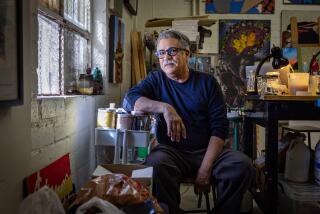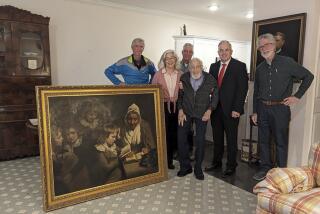Mark Stock dies at 62; painter known for butler images
Mark Stock, a painter known for his evocative portraits of white-gloved butlers and sad, stylish women in slinky gowns, has died. He was 62.
Stock, who died Wednesday at an Oakland hospital, had an enlarged heart, his publicist Charlotte Parker said.
His most famous painting, “The Butler’s in Love — Absinthe,” a study of a butler scrutinizing a lipstick smear on an empty glass, inspired a short David Arquette film, “The Butler’s in Love” (2008). It is one of more than 100 Stock paintings featuring butlers, often in poses suggesting suppressed longing or brooding disappointment.
Stock’s paintings, sometimes humorous and often haunting, appear to be poignant moments in broader, deeper stories. They point to “the heart that can no longer bear to remain well hidden,” Kazuo Ishiguro, a Japanese-born British author, once wrote. Ishiguro’s 1989 novel “The Remains of the Day” revolves around a butler whose love remains hidden.
Stock had done about 30 “butler” paintings before “The Remains of the Day” was published. He sent Ishiguro a fan letter and the two became friends over dinner in San Francisco, said Barnaby Conrad III, an author who wrote the artist’s biography in 2000.
“Each of his paintings had a certain short-story quality,” Conrad told The Times. “But he’d only start the stories; you’d have to finish them.”
In “Mark Stock: Paintings,” Conrad wrote that Stock’s works “connect viewers to the euphoria, loneliness, and sometimes fatal entanglements of romance.”
Death often does a tongue-in-cheek turn in Stock’s work. A dead man in white tie and tails lies prone, holding a bouquet. Another man lies rolled up in a Persian rug, his shoes sticking out, as a woman sits beside him, smoking a cigarette. Other paintings show dead men wearing plaid golfing togs: Stock himself was a golfer with an excellent, four-stroke handicap.
He also was a jazz drummer whose trio played at San Francisco clubs and a magician who entertained his friends with card tricks and sleight of hand.
“His floating dollar bill was legendary,” Doug Biederbeck, owner of Bix, a San Francisco restaurant that was one of Stock’s favorite watering holes, told the San Francisco Chronicle. “The Butler’s in Love — Absinthe” has hung in the restaurant since 1989, when it was commissioned to celebrate a history of absinthe written by Conrad.
But although Stock’s life had cosmopolitan trappings, he came from a background riddled with gothic horror: A great-great-grandmother was killed in an ax murder, both his grandfathers committed suicide and an aunt hanged herself in a closet.
“My work has an undercurrent of love, jealousy, loneliness, murder,” he told the Palm Beach Post in 1999.
The son of an Army officer, Mark Steven Stock was born Aug. 4, 1951, in Frankfurt, Germany, and grew up in various places throughout the U.S. where his father was posted. He attended community college in St. Petersburg, Fla., and in 1976 received a bachelor’s degree from the University of South Florida.
He soon headed for Los Angeles and landed a job as a lithographer at Gemini G.E.L., a fine arts publisher where he worked with luminaries such as Jasper Johns and David Hockney. A student of ballet and modern dance, he designed sets for the Los Angeles Chamber Ballet. He moved to the Bay Area after the Modernism Gallery in San Francisco started displaying his work.
However, Los Angeles remained an important spot for him.
“When I first arrived in L.A., the first thing I looked for was the Hollywood sign. I jumped out of my car … and a guy was coming out of a market and I screamed, ‘Hey, is that the Hollywood sign?’ I was obsessed,” he told The Times in 2013.
“Hollywood Uncovered,” a display of his work, had just opened at the Lora Schlesinger Gallery in Santa Monica. It featured his take on the famous sign, including, embedded in the letters, likenesses of Marilyn Monroe and Peg Entwistle, a 24-year-old actress who in 1932 jumped five stories to her death from the letter H.
In the early 2000s, Los Angeles Center Studios, a complex of soundstages, featured a succession of his murals, including one of a woman holding a glass to a wall in order to hear what’s happening next door.
“It’s a slow telling of story,” he said about his murals, “which is odd for L.A., because everything in L.A. happens so fast.”
The movies fascinated Stock, some of whose paintings had a film noir feel and were likened to the suggestive covers of old crime magazines.
Stock also was influenced by Charlie Chaplin, whose work he adored.
He once had a party in his studio for surviving cast and crew members from Chaplin’s “City Lights” (1931), Conrad said. When Chaplin died in 1977, Stock left roses at the star’s old haunts in Los Angeles, including his house and his studio.
Stock’s survivors include his longtime girlfriend, Sharon Ding, and a brother, Don Stock.
More to Read
Start your day right
Sign up for Essential California for the L.A. Times biggest news, features and recommendations in your inbox six days a week.
You may occasionally receive promotional content from the Los Angeles Times.







